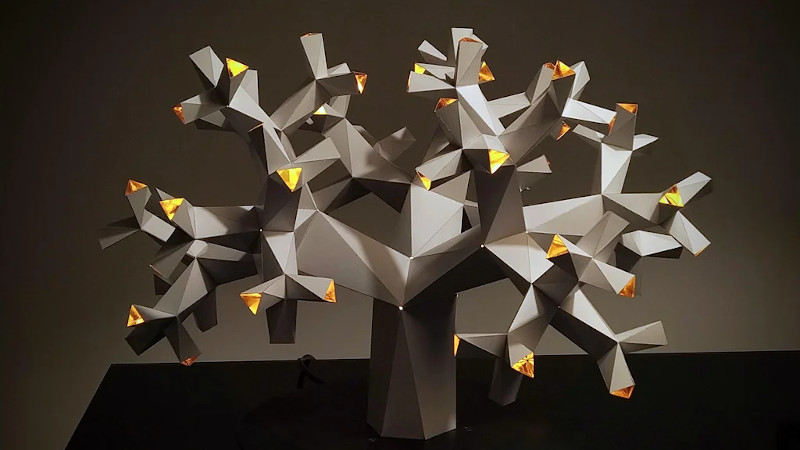Sometimes there are projects that we introduce with a bit of context, some background, and other times as with [RayP2]’s fractal papercraft tree, we introduce them simply because they are beautiful.
It’s a deceptively simple design of a repeating pattern of the same shape getting ever smaller with each iteration, and terminating in a tetrahedron with branches from each of its faces. It’s not origami, instead it’s a cut-and-glue design, and its construction is a surprisingly involved affair with some lateral thinking required to bend the tabs on the smaller branches. The design was first prototyped with plain paper, before a final version was made with card stock. The part that makes it exceptional is that he used shiny gold card stock with the gold side on the inside, meaning that when lit from the trunk the end of each branch glows attractively. Fitting the light required a modification to the trunk design, but this doesn’t take away from the whole.
The result is an attractive sculpture, a talking point, and something with a mathematical angle to boot, which we like. It’s certainly not been the first papercraft ptoject we’ve shown you, though perhaps these paper retrocomputers are a little less artistic.
















It’s kind of ironic! No, not that it’s made from paper or parts of a “tree”.
But is it art imitating nature?
Well nature imitates maths.
And this art imitates maths.
But is that because we created maths to imitate our observations of nature? If i have 5 apples and two oranges …
If you look at small trees emerging from the ground in the forest where all the soil has the same moisture and the temperature is the same for the whole plant and all the light is receives is diffused then you can see it has an exact formula.
Then sometimes you see in a plant how a cell has split and half of the cell split a second time before they all split again and how that has effected the formula of the plant.
So did fractals start as human creations or did they start as human observations?
Richard Feynman discussed your question at length with his colleagues. It’s one of those things…
Nature was full of fractals before we came to be, but we found them so cool we created more.
There are no geometric forms anywhere in the universe. No fractals, circles, triangles, etc. These things only exist in our MINDS often as part of the models we use to explain things. An asteroid in orbit around the sun doesn’t care that we might view it’s orbit as an elipse, bannana shaped, or anything else. It simply is what it is, tied up in causation like everything else.
Yay
Art and certainly not nature “imitate” math…but I think I understand what you mean when you say that this art piece “imitates math”
Neither was Math invented, although humans came up with a symbolic representation for it.
On the other hand humans _did_ invent theories of nature and formulae to describe them but I definitely wouldn’t say that they are an exact representation of nature.
…and I had fried rice for dinner…
I’m not sure that’s ironic
louder and more obnoxious they are also….makes it look like there are more….some aren’t that way, but they aren’t the ones in your face
You can be both atheist and agnostic. They are entirely separate things.
“God made the integers; all else is the work of man.”
-Theodore Kronecker
That’s only half true.
The question is does an Author of the universe, with full middle-knowledge, need numbers at all? Numbers seem to be man’s crutch, used in our partially effective efforts to understand this universe.
Yeah. The second half.
“half true”. Nice.